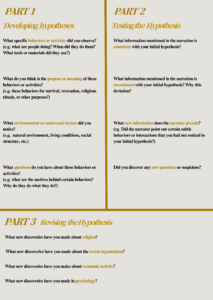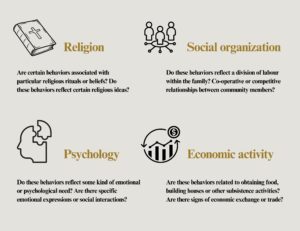Becoming an Ethnographic Documentary Observer: From Research Methods to the Screen

Summary
The toolkit will guide learners through the core research methods and ideas of ethnographic documentary: formulating hypotheses - testing hypotheses - revising hypotheses - forming speculations, and completing the initial exploration of ethnography by helping learners understand the connections between surface behavior and deeper cultural logic, and extract core meanings from complex cultural phenomena.
Ethnographic documentaries teach us that unfamiliar cultures are not far away, just unappreciated.
Introducing :
What is this: “Becoming an Ethnographic Documentary Observer: From Research Methods to the Screen” is an open toolkit to help learners understand the core research methods of ethnographic documentary research.
What is the goal: To master the basic ethnographic research process through mindfulness training and to understand how ethnographic documentaries document and analyze cultural phenomena through observation.
Learning Time: 20 minutes to complete the entire tutorial.
What You’ll Get:
A cultural logic: Learn through video observation the connection between superficial behaviors and deeper cultural logic, such as the influence of social rules, religious beliefs, or economic activities.
A way of thinking: Experience observation, hypothesis, validation, and revision as methods of ethnographic research to distill core meaning from complex cultural phenomena.
An inspiration of interest: Discovering cultural phenomena that interest you and recognizing the value of studying and expressing these elements.

📄Step 1: Initial Understanding of Ethnographic Documentary (3 minutes)
Goal: Understand the core methods of ethnographic documentary (observation, hypothesis, verification, revision) and get a general basic understanding of ethnographic documentary.
👉🏻 We recommend watching the three-minute introductory video, which explains in detail what the toolkit is for, the learning process, and what you will get. 👈🏻
All video material is original, and this video has subtitles and audio description for accessibility.
🎞️ If you choose to watch the video, you can skip this text.
📝 If you prefer to read, then here is the text version of the video:
Ethnography is a method of describing and analyzing human behavior in detail based on long-term field studies. Whereas an ethnographic documentary is a documentary that reflects an ethnographic understanding, the principle that an ethnographic documentary must be based on ethnographic knowledge is obvious and fundamental, and the use of an ethnographic understanding in the making of a documentary on an ethnographic subject will not only make the documentary more ethnographic but will also make the documentary more aesthetically pleasing.
If a film is to be based on an ethnographic understanding, a knowledgeable ethnographer must be closely involved as an ethnographer in every step of the film’s production.
The ideal arrangement is for the ethnographer to conduct fieldwork, complete his or her analysis and writing, and then return to the site with the filmmaker to make a film that thoughtfully builds on that writing. For example, in making the ethnographic documentaries Feast and Kepseli, ethnographer Chagnon spent two years researching the Yanomamo people of southern Venezuela and writing his booklet.
So now we will learn the core methods of ethnographic research: formulate a hypothesis – test the hypothesis – and revise the hypothesis- forming speculations. You will watch the film twice while filling out the form, and the first viewing will often leave you with an indigestible impression of the content of the film because you are completely unfamiliar with the subject matter of the film, at which point you will formulate your first hypothesis about the content of the film. However, on the second viewing, your ability to truly appreciate and absorb the documentary material will be greatly enhanced, at which point you will test the correctness of your first hypothesis and analyze the reasons for it in depth from the five dimensions, culminating in the formation of a complete form.
This logic corresponds to the reality of ethnographic research which is: hypotheses are formulated through field observations, and then more comprehensive field information is developed through in-depth interviews with the research subjects and analyses of anthropological data. Then, through repeated viewing of video materials, key information and cultural themes are gradually distilled, and finally, the cultural phenomenon under study is constructed into a coherent narrative structure.
🧩Step 2: Formulating the Hypotheses (5 minutes)
01 Choose an ethnographic documentary that interests you
Now, think of yourself as a human observer, you have entered the Human Observation Programme.
There are currently two options for you to choose from.
🚨Attention! You only need to choose one film to watch!
One is the ethnographic documentary film ‘Nanook of the North’ by American director Robert J. Flaherty. Documents the survival challenges and traditional way of life of the Nanook family, an Inuit family from Northern Canada, in their daily lives. The film shows how they hunt, fish and build igloos, reflecting the theme of harmonious coexistence between humans and nature.
👉🏻 The following is a silent, wordless version of Nanook of the North:
This video has been edited based on the original video. Since the original work was published in 1922, according to US copyright law, its copyright has expired. Therefore, the original video is not restricted by copyright and can be used, modified and distributed freely.
Original video source: Nanook of the North (1922). Directed by Robert J. Flaherty. Public Domain version available on Internet Archive. Retrieved from https://archive.org/details/NanookOfTheNorth-HD.
For the rule that automatically puts works published before 1923 in the public domain, see:
https://guides.library.cornell.edu/copyright/publicdomain
Another is the ethnographic documentary ‘Dance of the Dai Soul’ by Chinese director Jianglu Xiao, which captures two of the Dai dances of the ethnic minorities along the border of China’s Yunnan Province – the God Bird Dance and the Mountain God Dance – for which there is no video footage and which are on the verge of disappearing, and which combines the daily life of the Dai with the dances. The film combines the daily life of the Dai people with the dance, and closely links the primitive worship and beliefs of the nation with the dance.
👉🏻 The following is a silent, wordless version of Dance of the Dai Soul:
02 Download the recording form
Fill in the Part 1 (left part)of the form
Goal: To learn to extract initial hypotheses about behavioral and cultural phenomena from images through observation without narration.
You can either download the recording form on the web or divide the three main areas on real paper, examples are shown below:
📩 Web form download link:(Click it)👉🏻 Ethnographic Documentary Film Completion Form

⚠️ All questions in the form are for reference only, just to guide your answers.
You are free to record, not bound by the form, and the answer is not correct or wrong. ⚠️
03 Watch and record
Watch an ethnographic documentary of your choice —seeing the life of another type of person.
Note: Record observations, formulate initial hypotheses, and write down what you think happened. You can pause anytime you want to write.
Record every tiny thought, as these seemingly simple observations may be confirmed or disproved in subsequent voice-over films.
🔍Step 3: Testing the Hypothesis (5 minutes)
01 Watch the ethnographic documentary with narration again
Observe through the full film with narration to test or refute the initial hypothesis.
👉🏻 If you choose Nanook of the North, please click below:
This video has been edited twice based on the original video. Since the original work was published in 1922, according to US copyright law, its copyright has expired. Therefore, the original video is not restricted by copyright and can be used, modified and distributed freely.
Original video source: Nanook of the North (1922). Directed by Robert J. Flaherty. Public Domain version available on Internet Archive. Retrieved from https://archive.org/details/NanookOfTheNorth-HD.
👉🏻 If you choose Dance of the Divine Soul, please click below:
02 Watch with questions
Fill in the Part 2 (right part) of the form. (The following question is exactly the same as in the form)
-
What information mentioned in the narration is consistent with your initial hypothesis?
-
What information mentioned in the narration is inconsistent with your initial hypothesis? Why this deviation?
03 Compare and verify after viewing
Compare the information in the narration with your own initial assumptions, marking the differences from your initial assumptions.
-
What new information does the narrator provide? (eg. Did the narrator point out certain subtle behaviors or interactions that you had not noticed in your initial hypothesis?)
-
Did you discover any new questions or suspicions?
Refine the Part 2 (right part) of the form by thinking about it.
🪄Step 4: Revising the Hypotheses (6 minutes)
01 Five-dimensional thinking
Form a more comprehensive interpretive program based on new observations and understandings, covering non-visual cultural dimensions.

Think carefully and fill in the bottom part of the form.
02 Develop a comprehensive speculation
You will generate an ethnographic speculation of your hypothesis (about 50 words). As an ethnographic observer, how do you give a complete summary of your hypothesis? How would you present your observations to others? The template for writing content is as follows: (You can choose the reference template to write, or you can write freely)
From this video observation, I observed that…(person) did…(things) and…(things) in…(places). I believe the underlying reasons are… (religious, social, psychological, economic), which indicate…
Congratulations, you have completed an anthropological observation as a Human Observer!
This line of research can be effective in improving your appreciation of documentary film as a source. Not only have you studied documentaries with exceptional focus, but you have also taken the important step of viewing them with a more sensitive eye.
✉️Step 5: Upload hypotheses (1 minute)
01 Upload
You can upload your ethnographic speculation to the comments section below this open toolkits.
You can also leave a comment below responding to your feelings and trying to answer our questions.
Here are four questions to reflect on:
🌱 After completing your initial observations and assumptions, do you find that your understanding of cultural phenomena is biased? What factors might this bias come from (such as personal experience, cultural background, or observational habits)?
🌿 What information in a film with a narrative most upends your initial assumptions? How does this change help you more fully understand the cultural logic of the people you’re observing?
🌲 In the process of revising your assumptions, do you feel a deeper social, economic, or religious logic behind cultural phenomena? What does this logic tell you about your own cultural understanding?
🌴 What cultural phenomena have you become more interested in since completing the toolkit? If you were to research further or make a documentary on a cultural theme, what topic would you choose and why? How do you conduct research using the methods in the toolkit?
If you are learning the toolkit in a group, hold a workshop in the group afterwards to share your observations and hypotheses and deepen your understanding.
02 Resources for ethnographic research
If you still want to explore the mysteries of ethnography, then there are open learning resources for you to study and view below.
Google Arts & Culture provides digital resources and virtual experiences of cultural heritage around the world, providing rich visual and reference material for ethnographic studies that explore and compare different cultures. Link: https://artsandculture.google.com/
The Library of Congress website offers extensive ethnographic resources, including historical archives, field recordings, and cultural collections, enabling in-depth exploration of diverse traditions and communities. Link: https://www.loc.gov/discover/
Smithsonian Folklife and Cultural Heritage provides a rich resource for folk culture and music, with audio, video, and articles exploring in-depth the diversity of cultural traditions and practices around the globe. Link:https://folkways.si.edu/
The World Oral Literature Project preserves and shares oral literature in globally endangered languages, providing first-hand linguistic and cultural records for ethnographic research. Link:https://www.oralliterature.org/
Digital Himalaya brings together ethnographic research materials on the Himalayan region, including video, audio, maps, and manuscripts, to support regional cultural and social research. Link: https://digitalhimalaya.com/
With the exception of Nanook of the North, which is in the public domain, all of the images (Cover featured image included) and videos in the open toolkits were produced and shot by me independently.
Dance of the Dai Soul Unsubtitled and Unsubbed Version © 2024 by Jianglu Xiao is licensed under CC BY-NC-ND 4.0
《Dance of the Dai soul》One-minute plate © 2 by Jianglu Xiao is licensed under CC BY-NC-ND 4.0
Nanook of the North (without narration and subtitles) © 2024 by Jianglu Xiao is licensed under CC BY-NC-ND 4.0
Nanook of the North (without narration and subtitles) © 2024 by Jianglu Xiao is licensed under CC BY-NC-ND 4.0
Featured Picture by Jianglu Xiao is licensed under CC BY-NC-ND 4.0
Toolkit guide Picture 1 by Jianglu Xiao is licensed under CC BY-NC-ND 4.0
Toolkit guide Picture 2 by Jianglu Xiao is licensed under CC BY-NC-ND 4.0
Toolkit guide Picture 3 by Jianglu Xiao is licensed under CC BY-NC-ND 4.0
Original video source: Nanook of the North (1922). Directed by Robert J. Flaherty. Public Domain version available on Internet Archive. Retrieved from https://archive.org/details/NanookOfTheNorth-HD.


